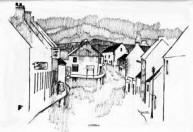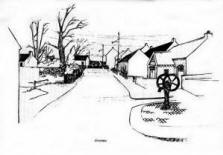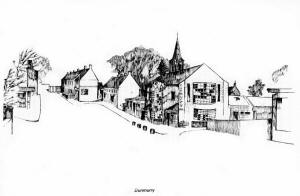|
Culcavy is a small industrial settlement one mile west of Hillsborough and
developed originally as a distilling centre using the nearby Lagan
Navigation Canal to receive raw materials. In the 19th century, distilling
was replaced by a woollen industry which was later superseded by linen
weaving. In the near future it is proposed to have a small industrial estate
in Culcavy.
 The little town of Dromara, sometimes obliquely described in a travel book
of many years ago, "Ballynahinch is a market town near to Dromara", nestles
in the hilly country which finds its heights in the beautiful Dromara
Mountains with Slieve Croob as their highest peak. Originally this was
Magennis territory but it passed into the possession of the Downshire family
who provided it with a market house. The little town of Dromara, sometimes obliquely described in a travel book
of many years ago, "Ballynahinch is a market town near to Dromara", nestles
in the hilly country which finds its heights in the beautiful Dromara
Mountains with Slieve Croob as their highest peak. Originally this was
Magennis territory but it passed into the possession of the Downshire family
who provided it with a market house.
The beauty of the countryside, long appreciated by the discerning traveller,
is being discovered by more people every year. Its relative "unknownness" is
traceable to the fact that while it is the centre of everywhere it was
by-passed by road and rail transport going to the larger towns around.
Because of that many were encouraged to believe that the professionally
recognised routes were the only ones available. Those who are prepared to go
off the beaten tracks will appreciate the beauties of the magnificent
panoramic scenery to be seen, especially from the Rib and Windy Gap roads
which meander over the mountains to Castlewellan and beyond. As many of the
holdings are small, farmers are often workmen in other capacities as well.
This is a constant reminder that Dromara was once the centre of flax growing
and of the mills which prepared the flax for use in the linen factories of
the Province. The demise of the linen industry meant that there was no
longer a single industry providing employment for large numbers of people.
Many Dromara people were compelled to leave the area, some went to Belfast,
to Britain, and many to countries around the world.
The district is well favoured by its churches. Two of them are of particular
historical and architectural value. There is the ancient church of St. John
(Church of Ireland) cruciform shaped now - the transepts were added in 1894
and reconstructed in 1811. In recent years the building has been restored
and new features added which enhance its appearance and add greatly to its
comfort. The first distinctive feature to impress the visitor is the fine
clock tower. The very pleasant interior has a peculiar attractiveness in its
simplicity. Two items are at once noticeable, the fine organ built by
Megahey of Cork in 1907 - it was electrified and re-built in 1957 - and the
James Pollock Memorial Window, installed and dedicated November 1974 in
memory of his 60 years as organist of the Church, 1912-1972.
The other church of architectural merit is First Dromara Presbyterian
Church, "The big meeting house". It was built in 1826 and is a typical barn
church of the period. Sited on Artana Hill it overlooks the countryside with
its hills and valleys, villages and towns, away to Black Mountain and Cave
Hill as they tower over Belfast itself. Much work has been done to the
fabric and furnishing of the edifice. The interior has been remodelled and
modern pews installed. Like St. John's, First Dromara Presbyterian Church
has beside it a church hall, the one dating from 1957, the other from 1974.
There are no immediate proposals to build new houses in the area.

Drumbo boasts the stump of one of the three round towers known to exist in
Co. Down looking like the ruin of a windmill behind the Presbyterian Church.
This church with its blackstone facade was built in 1882. ruin of a windmill behind the Presbyterian Church.
This church with its blackstone facade was built in 1882.
The Housing Executive are committed to the erection of further dwellings in
Drumbo, but at present the number is uncertain. It is unlikely that there
will be significant private development in the village.
Drumbeg has been described by the Parliamentary Gazetteer in 1846 as "Rich
in those features of landscape which possess beauty without grandeur,
picturesqueness without power. Villas are so numerous both within and
immediately beyond the limits as almost to melt into one another, and form a
pervading or general feature of the charming scenery." This to-day could
still adequately describe the parishes and hamlets on the Southern boundary
of Belfast except that there are fewer picturesque villas (country retreats)
than in past days. St. Patrick's Parish Church tower dates from 1798; the
spire from 1833 and the remainder of the Church from 1870. The bells date
from 1685.
The only further development of this village will be a limited extension of
the existing private housing.
To the north of the Borough Dundrod is on the route from Lisburn to Antrim
and Belfast Airport. It is on the low ground below Tullyrusk and the Be Hill
and the buildings comprise of a church, church hall, school and Post Office.
It is not expected that there will be any growth in the area in the near
future.
 Dunmurry, situated along the main Belfast/Lisburn Road, has expanded
considerably as a result of new private and public housing development. the
area is surrounded by open landscape including a golf course to the north,
the lower slopes of the Antrim Hills to the west, Moss Side to the south and
the Logan Valley to the east. The area is close to the Lagan Valley Regional
Park which is a valuable amenity beside such a large area of population. The
River Lagan flows through a lovely stretch of countryside here and
overlooking the area is the attractive Collin Mountain with its famous
Collin Glen. Close to Dunmurry is the village of Derriaghy, another
attractive little village. The parish church is of interest with church
registers dating from 1696. Dunmurry, situated along the main Belfast/Lisburn Road, has expanded
considerably as a result of new private and public housing development. the
area is surrounded by open landscape including a golf course to the north,
the lower slopes of the Antrim Hills to the west, Moss Side to the south and
the Logan Valley to the east. The area is close to the Lagan Valley Regional
Park which is a valuable amenity beside such a large area of population. The
River Lagan flows through a lovely stretch of countryside here and
overlooking the area is the attractive Collin Mountain with its famous
Collin Glen. Close to Dunmurry is the village of Derriaghy, another
attractive little village. The parish church is of interest with church
registers dating from 1696.
Edenderry is a village which grew up around the mill. The mill building of
early 19th century is on the site of a much older bleach-green. The
red-bricked terraces of the mill workers overlook the Lagan and the mill.
Near Edenderry is the prehistoric Giant's Ring, an ancient monument of great
size and simplicity. It is a great circular banked enclosure with a diameter
of over 600 feet with the remains of a dolmen in the centre.
 |